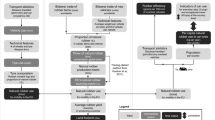Abstract
The Bio-Circular-Green economy (BCG) concept was originally started by the Thai government to promote national development and post-pandemic recovery in 2021. This study concentrates on the ways to increase the effectiveness of Thailand’s natural rubber exports. The primary goal is to evaluate Thailand’s natural rubber exports to ASEAN nations, in terms of their technical efficiency rankings. In order to achieve the main objectives based on the BCG concept (BCG policy measures in number 10: “investing in infrastructure”), the spatial dataset is applied with a stochastic frontier analysis model, which is called the panel spatial stochastic frontier analysis model estimation. The empirical results of this study to improve the technical efficiency of Thailand’s rubber export found that the infrastructure, especially the logistic system requirements of CLMV countries, needs to be addressed first. This is because the mixed spatial matrix (mixed-wij) represents significantly the level of logistics system development, which plays an important role in sustainably improving the technical efficiency. Therefore, the government and private sectors can use these empirical findings to promote policy recommendations in agricultural economics, especially the investment in logistic systems’ aspects of low carbon emissions and using renewable energy, which is the BCG concept.
Access this chapter
Tax calculation will be finalised at checkout
Purchases are for personal use only
Similar content being viewed by others
Notes
- 1.
- 2.
- 3.
- 4.
- 5.
References
Levin A, Lin C-F, Chu C-SJ (2002) Unit root tests in panel data: asymptotic and finite-sample properties. J Econometrics 108(Issue 1):1–24. ISSN 0304-4076. https://doi.org/10.1016/S0304-4076(01)00098-7
Brindha K, Elango L (2014) Spatial analysis of soil fertility parameters in a part of Nalgonda District, Andhra Pradesh, India. Earth Science India 7
Bucknell D, Pearson CJ (2006) A spatial analysis of land-use change and agriculture in eastern Canada. Int J Agric Sustain 4(1):22–38
Cambardella CA, Karlen DL (1999) Spatial analysis of soil fertility parameters. Precision Agric 1(1):5–14
Franch-Pardo I, Napoletano BM, Rosete-Verges F, Billa L (2020) Spatial analysis and GIS in the study of COVID-19. A review. Sci Total Environ 739:140033
Griffin TW (2006) Decision-making from on-farm experiments: a spatial analysis of precision agriculture data
Huo D (2014) Impact of country-level factors on export competitiveness of agriculture industry from emerging markets. Competitiveness Review
Latruffe L, Balcombe K, Davidova S, Zawalinska K (2004) Determinants of technical efficiency of crop and livestock farms in Poland. Appl Econ 36(12):1255–1263
Augustine L, Mulugetta M (2008) Assessing the influence of neighborhood effects on the adoption of improved agricultural technologies in developing agriculture. Afr J Agric Resour Econ
Maertens A, Barrett C (2012) Measuring social networks effects on agricultural technology adoption. Am J Agric Econ 95:353–359
Melati FC, Mayninda YP (2020) Technical efficiency of rice production using the stochastic frontier analysis approach: case in East Java Province. Ekuilibrium: Jurnal Ilmiah Bidang Ilmu Ekonomi 15(2):170–179
Pede VO, McKinley J, Singbo A, Kajisa K (2015) Spatial dependency of technical efficiency in rice farming: the case of Bohol, Philippines. In: Agricultural and applied economics association (AAEA) conferences, 2015 AAEA & WAEA joint annual meeting, July 26–28, San Francisco, California
Taraka K, Latif I, Shamsudin MN (2010) A nonparametric approach to evaluate technical efficiency of rice farms in Central Thailand. Southeast Asian J Econ 1–14
Taraka K, Latif IA, Shamsudin MN, Sidique SBA (2012) Estimation of technical efficiency for rice farms in Central Thailand using the stochastic frontier approach. Asian J Agric Dev 9(1362-2016-107597):1–11
Zamanian GR, Shahabinejad V, Yaghoubi M (2013) Application of DEA and SFA on the measurement of agricultural technical efficiency in MENA countries
Acknowledgements
This research was supported by CMU Junior Research Fellowship Program. And also, thanks to Thai Rubber Export for providing the data for the analysis of this research work.
Author information
Authors and Affiliations
Corresponding author
Editor information
Editors and Affiliations
Appendices
Rights and permissions
Copyright information
© 2023 The Author(s), under exclusive license to Springer Nature Singapore Pte Ltd.
About this paper
Cite this paper
Intapan, C., Chaiboonsri, C. (2023). Measuring the Technical Efficiency of Thai Rubber Export Using the Spatial Stochastic Frontier Model Under the BCG Concept. In: Shakya, S., Papakostas, G., Kamel, K.A. (eds) Mobile Computing and Sustainable Informatics. Lecture Notes on Data Engineering and Communications Technologies, vol 166. Springer, Singapore. https://doi.org/10.1007/978-981-99-0835-6_1
Download citation
DOI: https://doi.org/10.1007/978-981-99-0835-6_1
Published:
Publisher Name: Springer, Singapore
Print ISBN: 978-981-99-0834-9
Online ISBN: 978-981-99-0835-6
eBook Packages: Intelligent Technologies and RoboticsIntelligent Technologies and Robotics (R0)











